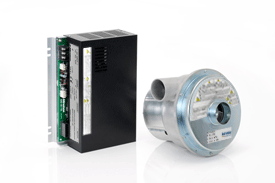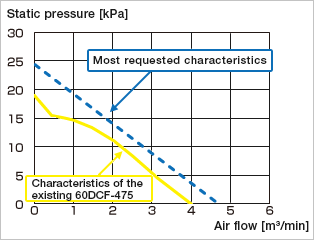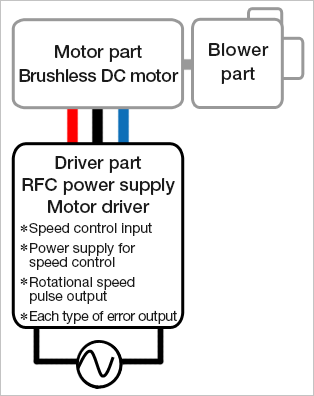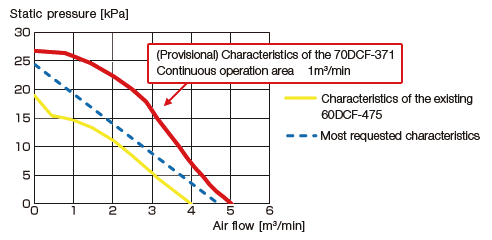Thorough review and brush-up, introducing the "70DCF series".

Since its April 2013 launch, the 70DCF series has long been popular as a high-pressure blower that offers both energy savings and high power.
Beginning with our initial 60DCF series, all of our high-pressure blower models have the following features as standard:
· Compact and lightweight design: Flexible installation is not limited to floor installation.
· Independent blower part and driver part: Flexible design is possible because the driver does not have to be close to the blower. Even if one part fails, the failed part can be replaced individually. This minimizes work suspension and realizes high maintainability that is impossible with a driver-integrated model.
The 70DCF series was launched to provide these features as well as to meet numerous customer requests.
Adoption of a brushless motor reduces the energy consumed by industrial instruments.
Around 2015, it became mandatory for industrial motors in Japan to be as efficient as those in Europe, and restrictions to encourage reduction of power consumption started to be established. These restrictions are not limited to three-phase induction motors. As a result, the entire industry has trended toward improving efficiency.
MinebeaMitsumi high-pressure blowers have employed a brushless motor since the initial 60DCF series, and they contribute to customers' environments by realizing high power with the aim of simultaneously attaining high efficiency and energy savings. The 70DCF series also adopts a brushless motor based on our accumulated expertise.
Objective: Pursuit of more powerful wind

Fig. 1: Characteristics of the existing 60DCF-475 (1200W) and requested characteristics
Our compact, lightweight, and high-power initial models, the 60DCF series, continue to be used by customers in various fields for a wide range of applications. However, as many customers have been using these models for a long time, we have started to receive many requests for a new series that has the same features but offers higher static pressure and larger air volume.
These requests have mainly concerned increases to both static pressure and air volume by about 30% from the 60DCF series, so we set a goal of doing so in our next-generation model.
Solution: Thorough review and brush-up

Fig. 2: Conceptual diagram of the high-pressure blower (We divided the blower into three factors and thoroughly reviewed each factor.)
Because the 60DCF series already has achieved the highest static pressure of 19 kPa, we started creating prototypes on the assumption that we could achieve "powerful wind" by altering the existing blower part slightly. However, this did not achieve the desired characteristics.
Searching for a solution, we decided to divide the 60DCF into three blocks and thoroughly analyze each block rather than to partially improve performance in order to develop the 70DCF series. Specifically, we broadly divided the 60DCF into a blower part, motor part, and driver part, and we carefully reviewed each part starting with the fundamentals in order to make improvements so that the overall product could achieve the characteristics requested by customers when assembled.
Blower part
We also tried various combinations of blade thicknesses, sizes, step counts, blade counts, and blade casings, repeatedly prototyping samples to determine the optimal combination, and we successfully improved the efficiency of the blower part itself by 4%.
Motor part
In light of recent trends, we adopted magnets free of rare earths and analyzed the magnetic field for optimization.
Because we excel at inner rotor high-speed brushless motors, we replaced the outer rotor brushless motor in the 60DCF series with an inner rotor motor, leveraging our expertise and accumulated historical data. At the same time, we considered a design that inhibits vibration even when the motor outputs high power.
In addition, we repeatedly carried out other analyses and prototyping to ultimately achieve an efficiency of about 95% in the motor alone (internal measurement).
Driver part
We successfully improved the overall efficiency of the driver part by about 5%.
We achieved this improvement by employing a new method and elements in the PFC (Power Factor Correction) part of the power supply part to reduce heat generation (including reducing the size of the heat dissipation fin) and reviewing the motor driver elements.
We also improved the signal input section used by customers to respond to customer requests regarding the 60DCF series so that the signal input section can output a dedicated power supply for speed control input and be driven just by externally connecting a resistor.
In addition, we improved the output section to make the rotational speed pulse output independent in order to allow it to be treated separately from each type of error output.
To ensure safety, reinforced insulation is applied to these input/output parts.
Result: 30% efficiency improvement for the overall system

Fig. 3: Characteristics of our new product, the 70DCF-371, and what customers requested
By broadly dividing the product into three factors and thoroughly reviewing each—the blower, motor, and driver parts—we successfully improved overall efficiency by about 30%.*1
As a result, the 70DCF-371's characteristic curve exceeds what customers have requested.
We have confirmed top-grade power for a brushless blower, a maximum static pressure of 28 kPa, and a maximum air volume of 4.8 m3/min.*2 By thoroughly analyzing each part based on numerous customer requests, we have created the 70DCF-371, the new ideal for high-pressure blowers that are compact and energy saving despite their high power.
*1 Compared to our previous model
*2 Internal measurement
